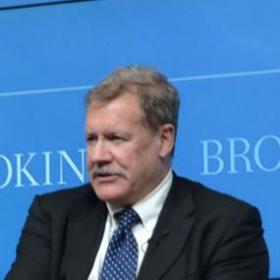
IAEA Confusion on Iran is Not Helpful
EWI's Greg Austin argues that the latest IAEA report on Iran's nuclear program does not present convincing evidence that the country has taken decisive steps since 2003 to design or produce nuclear weapons.
According to the United States, “Iran is keeping open the option of developing nuclear weapons”. This written statement of 10 February 2011 by the Director of National Intelligence, General James Clapper, implies a belief that Iran was not then developing nuclear weapons. Clapper also said that Iran believes it can deter its adversaries with its conventionally armed missiles. There are other reports in the public domain from US intelligence agencies supporting these views. In 2007, the CIA assessed with high confidence that Iran called a halt to its nuclear weapons program in 2003.
Intelligence sources have told this author that the Iranian government appears to have decided to abandon its nuclear weapons work in 2003 and that it did not return to that nuclear weapons design or testing after 2003. At the same time, Iran does continue to develop two enabling technologies for developing nuclear weapons should it choose to do so, enriched uranium and ballistic missiles. This is exactly what U.S. intelligence officials appear to be saying in public on the record. Iran is obliged under its international legal commitments to reveal all military related aspects of its nuclear program, whether these were in the past or the present. The current United Nations Security Council resolutions and continued concerns of the International Atomic Energy Agency (IAEA) about Iran’s military nuclear activities relate to the period of Iranian weapons related work before the end of 2003, and to Iranian concealment after 2003 of that previous activity.
The recent IAEA Board of Governors’ report (8 November 2011) includes a special Annex that “provides a detailed analysis of the information available to the Agency to date which has given rise to concerns about possible military dimensions to Iran’s nuclear programme”. The Report and its Annex reveals no specific evidence of Iranian government development of a nuclear weapon that is specifically dated by the report after 2003. The report claims a good knowledge of events before 2003, but acknowledges that the “Agency’s ability to construct an equally good understanding of activities in Iran after the end of 2003 is reduced, due to the more limited information available.”
The IAEA report goes on to say: “The information indicates that Iran has carried out some research activities that might be relevant to the development of a nuclear explosive device.” This does relate to activities dated “after 2003”, but the report notes that the activity also had civil applications.
The report says that IAEA information “indicates that prior to the end of 2003, these activities took place under a structured programme, and that some activities may still be ongoing.” It appears to reveal uncertainty whether such activities continued after 2003 at all. It does not describe a comprehensive set of weaponization activities that continued after 2003, rather some inconclusive evidence that possibly it did. By contrast, the IAEA has very detailed information on different strands of weaponization research and design that occurred up to the end of 2003, such as trigger design and safety arrangements for nuclear testing. The IAEA report can be faulted in many places for putting dates on certain information and the activities described in that information and not on others, or conflating past events of almost a decade ago and the present, as in the excerpts above. The report can be faulted for not indicating which military activities “may” be “ongoing” and when exactly they occurred. Those governments holding well-sourced evidence of Iranian nuclear weapons development after 2003 should share it publicly. The IAEA report is not that helpful in trying to get at the facts. It paints a less than convincing picture that the Iranian government is now pursuing a weaponization program.
Photo: "Thiep Nguyen (01611296)" (CC BY-SA 2.0) by IAEA Imagebank

